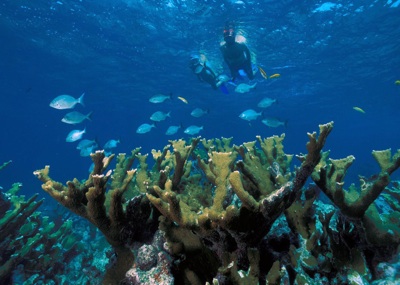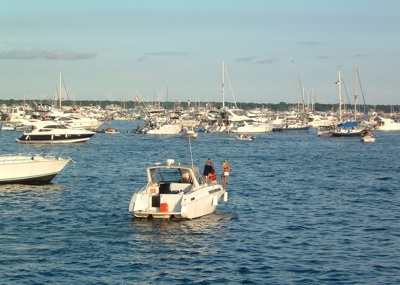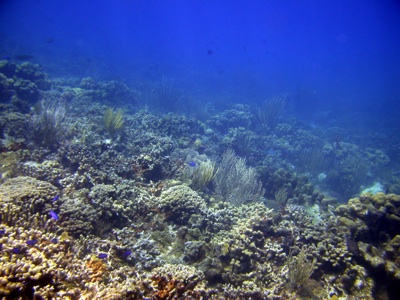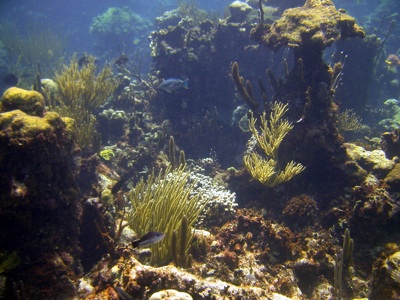
Marine parks endangered by human use
Off the coast of South Florida lay tropical tranquil waters that risk complete destruction. Across miles of Caribbean oceans is another similar environment being threatened by the same dangers.
The National Park Service protects two tropical marine parks in Atlantic waters that may not be around for future generations to see if something does not change. The natural environments of Biscayne National Park in Homestead, Fla., and Buck Island Reef National Monument, located in the U.S. Virgin Islands, are both being endangered in many ways by humans.
According to the National Park Service, Biscayne National Park is 173,000 acres, 22 miles long, 14 miles wide and 95 percent underwater.
| At right, snorkelers explore the reef in Biscayne National Park. Below, boaters in Biscayne National Park (Photos courtesy of Biscayne National Park). |  |
Park Ranger and Spokesperson Gary Bremen said that the park visitor center on land receives only about 50,000 visitors a year, while the park estimates it receives a total of more than one million visitors a year.
As the United States’ largest marine park with at least 95 percent of its visitors coming to the park for water recreation activities, the park staff and National Park Service must concern themselves with the environmental health of the park to an even greater extent than at other parks.
“Unlike most parks . . . people don’t even know they’re in the park,” Bremen said. “You don’t have a fence around the outside,” he added.
The unique situation of marine parks makes them all the more difficult to protect. Threats to the parks include a vast array of dangers including water pollution and water quality, boats running aground, exotic invasive species, significant loss of fisheries, loss of coral reef cover and global climate change.
These threats jeopardize endangered species that call the park home. For example, the West Indian manatee, eastern indigo snake, piping plover, American crocodile, peregrine falcon, Schaus’ swallowtail butterfly, least tern, and five species of sea turtle, can all be found in Biscayne National Park.
 Some threats can very clearly be pinned on park visitors and other outside human interference. For example, boats run aground by visitors, can damage sea grass beds and coral reefs.
Some threats can very clearly be pinned on park visitors and other outside human interference. For example, boats run aground by visitors, can damage sea grass beds and coral reefs.
Likewise, anglers are also responsible for the reduction of fisheries.
It is the responsibility of Matt Patterson, Inventory and Monitoring Network coordinator for the South Florida and Caribbean network, to understand and track how the natural resources of the parks are doing.
These natural resources include everything from species of fish, in Key Biscayne to the entire coral reef in the Virgin Islands.
“The entire park has already been so over-fished,” Patterson said.
According to Patterson, the inventory and monitoring team had to go on more than 60 dives to find a single legal size grouper in Biscayne National Park.
Due to urban pressure and pollution, the coral reefs in Biscayne Bay are not as resilient as reefs in less populated areas.
“Until we can manage the fishery better there are so many things we can’t do,” Patterson said, referring to any further efforts to improve and protect the ecosystem in the park.
The park is already looking into a new fisheries management plan to protect species that are being over-fished. The current regulations are impractical because they designate certain areas at different levels of protection.
Some parts of Biscayne Bay are under the National Park Service’s jurisdiction, while others are under only the State of Florida’s regulations. For this reason, anglers are frequently in violation of the park’s rules without even realizing they’ve slipped into the territory of the national park.
“Imagine yourself as an angler . . . it’s no wonder that people are getting in trouble,” Bremen said, understanding the confusing nature of current fishing regulations in the water in and around Biscayne National Park.
According to Bremen, though at first quite limiting, the eventual elimination of all fishing within national park boundaries would be far clearer and easier to follow for anglers.
In addition to the humans, invasive species also threaten the natural inhabitants of the park. Invasive species are non-native plants and animals brought into an environment that threaten the natural ecosystem in that environment.
| At right and below, two of the endangered reefs that are part of the U.S. Virgin Islands National Park (Photos courtesy of Matt Patterson). |  |
Bremen cited anacondas and lionfish as some of the invasive, exotic species found in the park.
According to the National Park Service, lionfish were found in Biscayne National Park for the first time in recent years in June of 2009.
“This invasive species of fish [is] likened to underwater locusts and considered a serious threat to Florida’s marine life . . . Once introduced lionfish can rapidly become an established species that poses potential problems for both the environment and humans,” the National Park Service stated in a recent news release.
In addition to distinctly human threats, there are also other dangers to the natural environment of Biscayne National Park. Coral reef cover—the amount of coral reef covering the ocean floor—is down all over the world, as much as 40 percent to 60 percent in some places, and global climate change, which scientists believe poses a threat all over the world, is especially a concern in marine environments.
“Global climate change is an enormous issue impacting the park,” Bremen said.
In addition to rising water levels, he also expressed concern about ocean acidification as a result of global climate change. A higher level of acidity in the ocean, even a small change, would directly impact animals like crabs and shrimp that make their shells out of calcium.
As a result, entire food chains would be impacted, resulting in “massive species loss,” according to Bremen.
These dangers also threaten Buck Island Reef, one of the Caribbean’s best reefs. In 2005 and 2006, Buck Island Reef and the rest of the Virgin Islands experienced a dramatic coral bleaching event.
Coral bleaching refers to the process wherein a tiny microorganism that lives inside of coral separates from the coral due to especially high water temperatures. The coral are reliant on a symbiotic relationship with the organism to get their food and rapidly disease and die out when this happens. The microorganism gives the coral its color so when the organism is gone, the coral appears bleached, giving the occurrence its name.
 The high water temperatures in 2005 were a result of weather conditions in the Virgin Islands that appeared perfect to tourists. Skies were very rarely overcast and waters were very calm, allowing water temperatures to rise well above the normal level.
The high water temperatures in 2005 were a result of weather conditions in the Virgin Islands that appeared perfect to tourists. Skies were very rarely overcast and waters were very calm, allowing water temperatures to rise well above the normal level.
After 90 percent of the coral bleached, water temperatures returned to normal within a few months, but the weakened coral were then susceptible to disease. Patterson referred to the combination of events as a “one-two punch.”
Scientists were able to recognize the causes of the disease due to increased monitoring following the coral bleaching, though they are now at a loss to undo the damage.
Efforts being made include adding more mooring buoys to be used by boats, so that anchors do not damage the reefs; working with partners to identify the causes of coral reef disease; and education and outreach.
“[Visitors] don’t realize that most of it is just dead,” Patterson said.
Divers still see colorful coral and fish and so assume the ecosystem is healthy. According to Patterson, the park is focusing on explaining to visitors how the reef used to be truly alive and vibrant.
It is an ongoing challenge to restore the coral reef ecosystems in the U.S. Virgin Islands and Biscayne National Park, but according to Patterson, “We haven’t given up hope. We are seeing some positive signs that the reef can survive.”
If You Go to Biscayne National Park:
- Pets are welcome at Convoy Point and the developed areas of Elliott Key as long as they are on an attended leash. With the exception of service animals, pets are prohibited in other areas of the park.
- There are no restaurants in the park, but the park’s concessioner offers cold sandwiches, snacks and drinks.
- Things to do without a boat: explore the Dante Fascell Visitor Center, watch a film or attend a ranger program, walk the Jetty Trail (approximately 1/4 mile long), or have a picnic.
- Guided boat tours including transportation to Elliott Key (from November to May) and canoe and kayak rentals are available to get beyond Convoy Point.
- There are two campgrounds in the park. They are accessible by boat only. There are no RV sites in the park.
- The park visitor center is located at: 9700 SW 328 St., Homestead, Fla., 33033.
If You Go to Buck Island:
- Travel to the park can be made only on approved concessionaires from Christiansted, St. Croix, or by personal boat.
- Full and half day charters are available but you must charter from only the authorized concessionaires. Contact the park for a list of concessionaires at 340-773-1460.
- Local custom and town ordinances require that you wear shirts or cover-ups in Christiansted.
- Water skiing, Jet Skiing and spear fishing are prohibited in the park.
- Anchoring is prohibited in the lagoon; boats must pick up a mooring.
Scuba diving is prohibited at the underwater trail but allowed at the two scuba moorings in the north lagoon. Do not stand on or handle coral. If you tire while snorkeling, use the rest floats. - Don’t feed the fish.
- The island closes to visitors at sunset.
- Pets, vehicles (except wheelchairs) artificial light, camping, glass containers, generators, and loud music are prohibited.
- Build fires only in the grills provided by the National Park Service.
- Digging tent poles, beach umbrellas and stakes is prohibited on beaches.

Comments are Closed